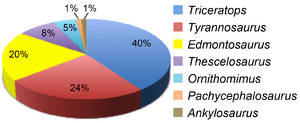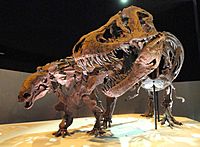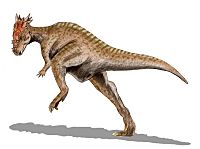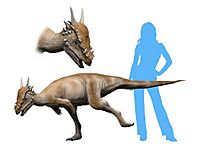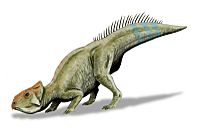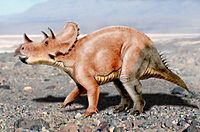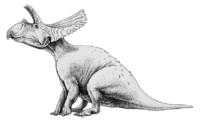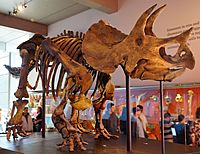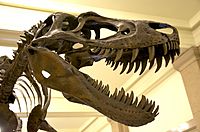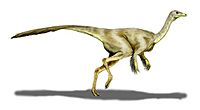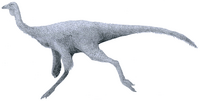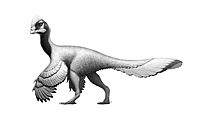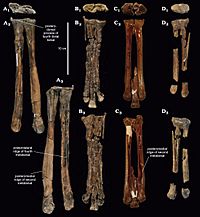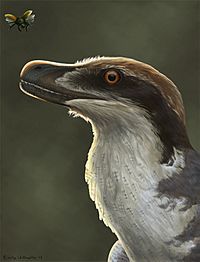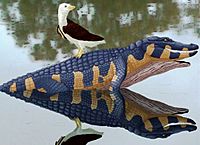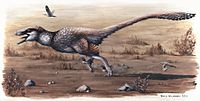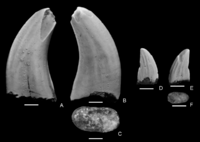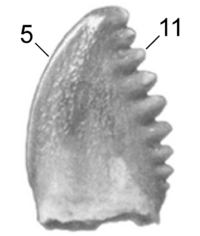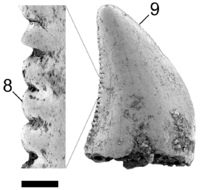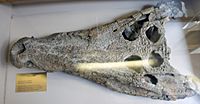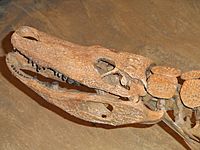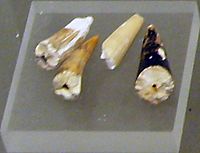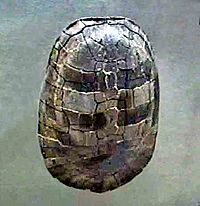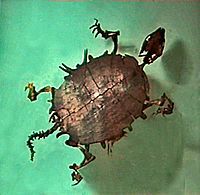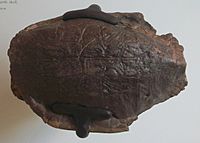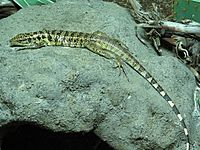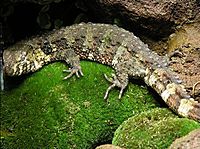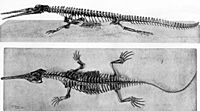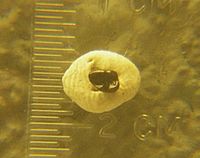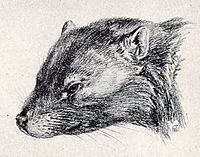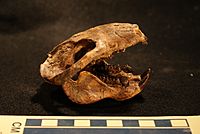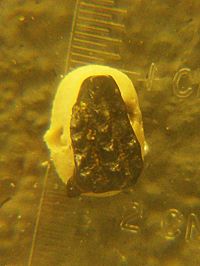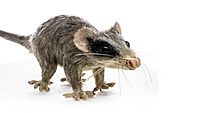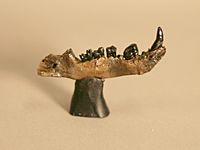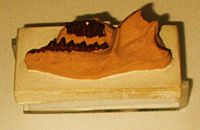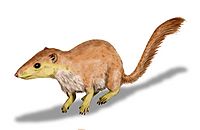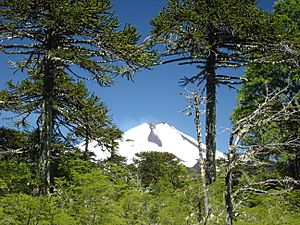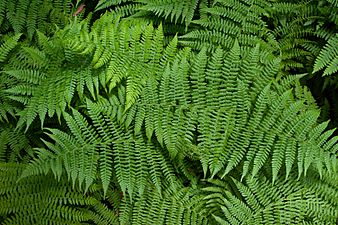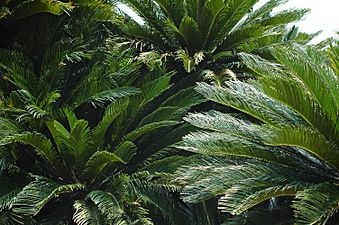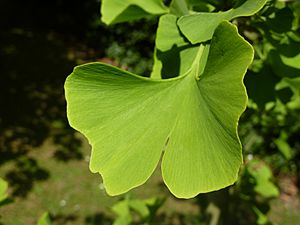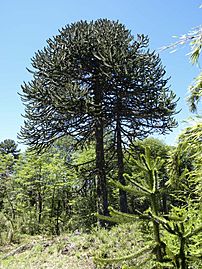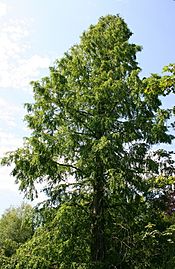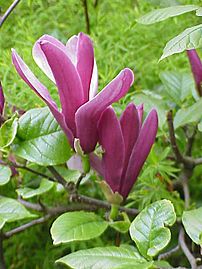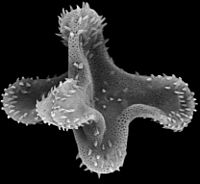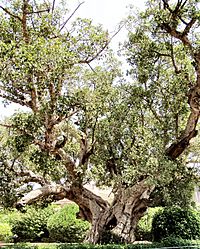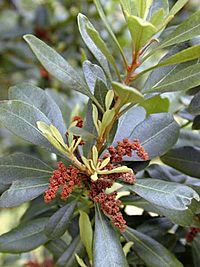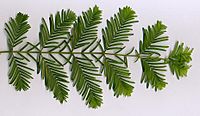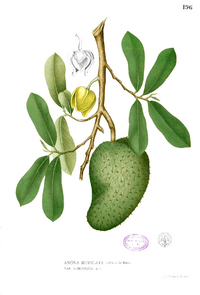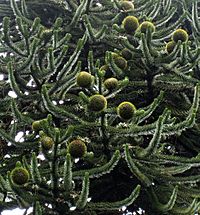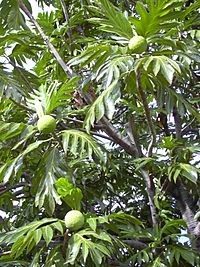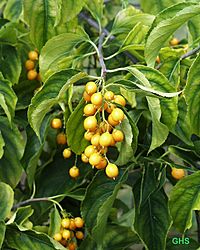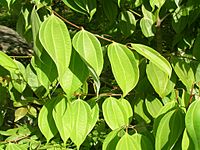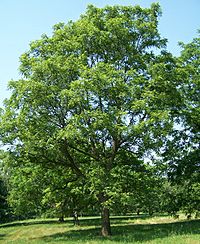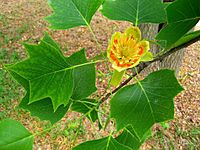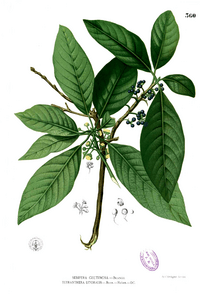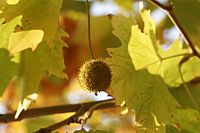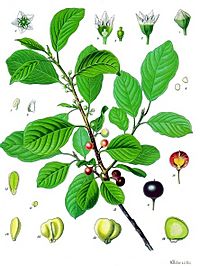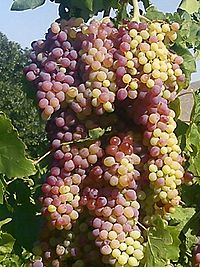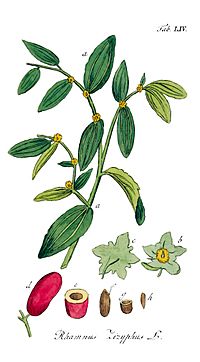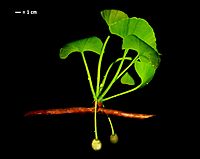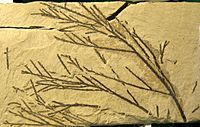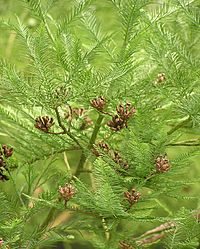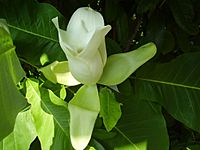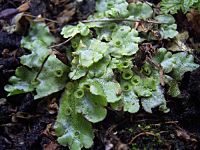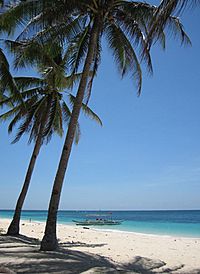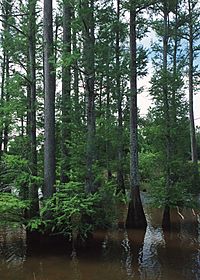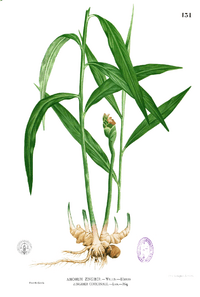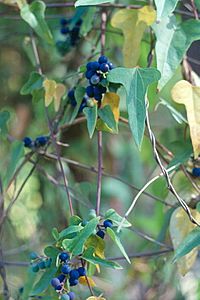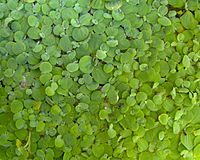Paleobiota of the Hell Creek Formation facts for kids
This is an overview of the fossil flora and fauna of the Maastrichtian-Danian Hell Creek Formation.
Contents
Invertebrates
Insects like Diptera, Zygopteran, and possibly hemiphlebiid damselflies have been unearthed in Hell Creek in amber. Fossils found in the Hell Creek Formation and the Fort Union Formation of these insects went extinct during the K-T Event.
| Invertebrates | ||||||
|---|---|---|---|---|---|---|
| Genus | Species | Location | Stratigraphic position | Material | Notes | Images |
| Plesielliptio | P. postbiplicatus | Fresh water Pelecypod | ||||
| P. gibbosoides | ||||||
| P. whitfieldi | ||||||
| Rhabdotophorus | R. aldrichi | |||||
| Pleurobema | P. cryptorhynchus | |||||
| Plethobasus | P. aesopiformis | |||||
| P. biesopoides | ||||||
| Quadrula | Q. cylindricoides | |||||
| Proparreysia | P. verrucosiformis | |||||
| P. holmesiana | ||||||
| P. barnumi | ||||||
| P. percorrugata | ||||||
| P. pyramidatoides | ||||||
| P. letsoni | ||||||
| P. retusoides | ||||||
| P. corbiculoides | ||||||
| P. paucinodosa | ||||||
| ?Obovaria | ?O. pyramidella | |||||
| Corbicula | C. cf. subelliptica | |||||
| C. sp | From a marine facies ("tongue") in South Dakota. Modern members of this genus live in fresh water | |||||
| Sphaerium | S. beckmani | "Pill clam". "Nut clam". "Fingernail clam". "Pea clam". Family Sphaeriidae. |  |
|||
| Pleiodon | Indeterminate | |||||
| Campeloma | C. sp | Freshwater snail | ||||
| Anomia | A. gryphorhyncha | Bivalve. Family Anomiidae. From a marine facies ("tongue") in South Dakota. | ||||
| Crassostrea | C. subtrigonalis | Oyster. Family Ostreidae. Collected from a marine facies ("tongue") in South Dakota. | ||||
| Granocardium | G. sp | Bivalve. Family Cardiidae (cockle). Collected from a marine facies ("tongue") in South Dakota. | ||||
| ?Hiatella | ?H. sp | Bivalve. Present members of this genus are rock borers. Collected from a marine facies ("tongue") in South Dakota. | ||||
| Leptosolen | indeterminate | Bivalve. Family Cultellidae. Collected from a marine facies ("tongue") in South Dakota. | ||||
| Sphenodiscus | S. lenticularis | Ammonite. From a marine facies ("tongue") in South Dakota. | ||||
| Discoscaphites | D. rossi | Microconch of an ammonite. From a marine facies ("tongue") in South Dakota. | ||||
| Scaphitidae | indeterminate | Ammonite. From a marine facies ("tongue") in South Dakota. Other attributes: specimen has hooks on its shell. | ||||
| Cephaloleichnites | C. strongi | hispine beetle. ("leaf beetle") | ||||
Amphibians
Color key
|
Notes Uncertain or tentative taxa are in small text; |
| Amphibians reported from the Hell Creek Formation | |||||||
|---|---|---|---|---|---|---|---|
| Genus | Species | State | Stratigraphic position | Material | Notes | Images | |
|
Anura (frog) |
indeterminate |
|
Middle to upper Hell Creek Formation |
3 unassigned specimens |
Anura indet. consists of material not currently assigned to any genus of frog. |
||
|
Barbourula |
Indeterminate |
|
|||||
|
Caudata (salamander) |
indeterminate |
|
Lower to uppermost Hell Creek Formation |
149 unassigned specimens |
Material of Caudata indet. is not currently assigned to any genus. |
||
|
Eopelobates |
Indeterminate |
|
|||||
|
Habrosaurus |
H. dilatus |
|
Middle to upper Hell Creek Formation |
6 specimens |
|||
|
Lisserpeton |
L. bairdi |
|
|||||
|
Opisthotriton |
O. kayi |
|
Lower to upper Hell Creek Formation |
22 specimens |
Opisthotriton is classified as a Batrachosauroididae. |
||
|
P. garbanii |
|
A member of Proteidae. |
|||||
|
Proamphiuma |
P. cretacica |
|
|||||
|
Prodesmodon |
P. copei |
|
|||||
|
Scapherpeton |
S. tectum |
|
Lower to upper Hell Creek Formation |
144 specimens |
Scapherpeton is a scapherpetonid that is very common in the Hell Creek Formation. |
||
|
Scotiophryne |
S. pustulosa |
|
A small frog |
||||
Fish
Bony fish
| Bony fishes | ||||||
|---|---|---|---|---|---|---|
| Genus | Species | Location | Stratigraphic position | Material | Notes | Images |
| Acipenser | A. eruciferus |
|
A sturgeon | |||
|
cf. A. sp. |
|
Lower to upper Hell Creek Formation |
18 specimens are tentatively assigned to Acipenser sp. |
Acipenser sp. is tentatively referred to the genus. |
||
|
A. fragosa |
|
small amiid fish (ubiquitous). Closely related to the modern Bowfin |
||||
| Belonostomus | B. longirostris |
|
Lower to upper Hell Creek Formation | 28 specimens | A long-snouted slender fish classified as an aspidorhynchid. | |
| Coriops | C. amnicolus |
|
||||
| Kindleia | K. fragosa |
|
Lower to uppermost Hell Creek Formation | 2610 specimens have been assigned to Kindleia, making it an extremely common genus. | Kindleia is a genus assigned to Amiidae, along with Melvius and Amia. | |
| Lepisosteus | L. occidentalis |
|
Lower to uppermost Hell Creek Formation | 938 specimens are assigned to Lepidosteus | A lepidosteid that is very common in the Hell Creek Formation. | 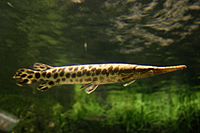 |
| Melvius | M. thomasi |
|
Lower to upper Hell Creek Formation | 6 specimens are assigned to Melvius | A large amiid fish. | |
| Phyllodus | P. paulkatoi | Fish with columnar teeth | ||||
| Palaeolabrus | P. montanensis |
|
||||
| Paleopsephurus | P. wilsoni |
|
A paddlefish | |||
| Palaeolabrus | P. montanensis | Fish (incertae sedis) | ||||
| Paralbula | P. casei |
|
||||
| Platacodon | P. nanus |
|
Small teleost fish | |||
| Protamia | Indeterminate |
|
||||
| Pachyrhizodontoidei | Indeterminate | Fish | ||||
| Protoscaphirhynchus | P. squamosus |
|
A sturgeon | |||
Cartilaginous fish
| Chondrichthyes reported from the Hell Creek Formation | ||||||
|---|---|---|---|---|---|---|
| Genus | Species | Location | Stratigraphic position | Material | Notes | Images |
|
Chiloscyllium |
C. sp. |
A member of Hemiscylliidae. |
||||
|
Galagadon |
G. nordquistae |
|
Isolated teeth |
A carpet shark |
||
|
Lonchidion |
L. selachos |
|
Lower to upper Hell Creek Formation |
40 specimens |
A genus of prehistoric sharks in the family Hybodontidae. It makes up 0.4% of the remains of the vertebrates of the Hell Creek Formation. |
|
|
Myledaphus |
M. pustulosus |
|
Lower to upper Hell Creek Formation. |
1677 specimens previously assigned to M. bipartitus. |
Is an anacoracid batoid rajiform related to guitarfishes. Described on the basis of teeth formerly assigned to the species M. bipartitus. The material assigned to Myledaphus bipartitus and makes up 16.5% of the vertebrate remains. |
|
|
Protoginglymostoma |
P. estesi |
A member of Ginglymostomatidae. Formerly assigned to the genus Brachaelurus. |
||||
|
Restesia |
R. americana |
|
Middle Hell Creek Formation |
5 specimens previously assigned to Squatirhina |
A wobbegong-like shark. Formerly assigned to Squatirhina. The remains consist of 0.05% of the vertebrates. Also known from the Lance Formation. |
|
|
Carcharhinidae indet. |
Indeterminate |
|
An isolated tooth. |
|||
Dinosaurs
A paleo-population study is one of the most difficult of analyses to conduct in field paleontology. Here is the most recent estimate of the proportions of the eight most common dinosaurian families in the Hell Creek Formation, based on detailed field studies by White, Fastovsky and Sheehan (1998).
- Ceratopsidae 61%
- Hadrosauridae 23%
- Ornithomimidae 5%
- Tyrannosauridae 4%
- Hypsilophodontidae 3%
- Dromaeosauridae 2%
- Pachycephalosauridae 1%
- Troodontidae 1% (represented only by teeth)
Outcrops sampled by the Hell Creek Project were divided into three sections: lower, middle and upper slices. The top and bottom sections were the focus of the PLoS One report, and within each portion many remains of Triceratops, Edmontosaurus, and Tyrannosaurus were found. Triceratops was the most common in each section, but, surprisingly, Tyrannosaurus was just as common, if not slightly more common, than the hadrosaur Edmontosaurus. In the upper Hell Creek section, for example, the census included twenty two Triceratops, five Tyrannosaurus, and five Edmontosaurus.
The dinosaurs Thescelosaurus, Ornithomimus, Pachycephalosaurus and Ankylosaurus were also included in the breakdown, but were relatively rare. Other dinosaurs, such as Sphaerotholus, Denversaurus, Torosaurus, Struthiomimus, Acheroraptor, Dakotaraptor, Pectinodon, Richardoestesia, Paronychodon, Anzu, Leptorhynchos and Troodon (more likely Pectinodon), were reported as being rare and are not included in the breakdown.
The dinosaur collections made over the past decade during the Hell Creek Project yielded new information from an improved genus-level collecting schema and robust data set that revealed relative dinosaur abundances that were unexpected, and ontogenetic age classes previously considered rare. We recognize a much higher percentage of Tyrannosaurus than previous surveys. Tyrannosaurus equals Edmontosaurus in U3 and in L3 comprises a greater percentage of the large dinosaur fauna as the second-most abundant taxon after Triceratops, followed by Edmontosaurus. This is surprisingly consistent in (1) the two major lag deposits (MOR loc. HC-530 and HC-312) in the Apex sandstone and Jen-rex sand where individual bones were counted and (2) in two thirds of the formation reflected in L3 and U3 records of dinosaur skeletons only.
Triceratops is by far the most common dinosaur at 40% (n = 72), Tyrannosaurus is second at 24% (n = 44), Edmontosaurus is third at 20% (n = 36), followed by Thescelosaurus at 8% (n = 15), Ornithomimus at 5% (n = 9), and Pachycephalosaurus and Ankylosaurus both at 1% (n = 2) are relatively rare.
Fossil footprints of dinosaurs from the Hell Creek Formation are very rare. As of 2017, there is only one find of a possible Tyrannosaurus rex footprint, dating from 2007 and described a year later.
Ornithischians
Ankylosaurs
| Ankylosauria reported from the Hell Creek Formation | ||||||
|---|---|---|---|---|---|---|
| Genus | Species | State | Stratigraphic position | Material | Notes | Images |
|
A. magniventris |
|
An ankylosaur. Also found in the Lance and Scollard Formations. |
||||
|
Denversaurus |
D. schlessmani |
|
A nodosaurid ankylosaur. |
|||
Pachycephalosaurs
An undescribed Pachycephalosaur is present in North Dakota. Pachycephalosaur remains have been unearthed in Montana as in the case of the now invalid genus Stenotholus kohleri which is now a junior synonym of Pachycephalosaurus.
| Pachycephalosaurs reported from the Hell Creek Formation | ||||||
|---|---|---|---|---|---|---|
| Genus | Species | State | Stratigraphic position | Material | Notes | Images |
|
D. hogwartsia |
|
|
A pachycephalosaur, possibly synonymous with Pachycephalosaurus. |
|||
|
P. wyomingensis |
|
A pachycephalosaur. Also found in the Lance Formation. |
||||
|
Sphaerotholus |
S. buchholtzae |
|
|
"Skull material." |
A pachycephalosaur whose remains have been found in the Frenchman Formation, Kirtland Formation, and the Horseshoe Canyon Formation. |
|
|
S. spinifer |
|
A pachycephalosaur, possibly synonymous with Pachycephalosaurus. Also found in the Ferris Formation and the Lance Formation. |
||||
Ceratopsians
Indeterminate ceratopsid teeth and some identifiable bones from Triceratops can be extremely common. 8.31% of all vertebrate remains from the Hell Creek Formation are unassigned ceratopsids. In 2012, a new unidentified species of chasmosaur ceratopsian with noticeable differences from Triceratops was unearthed in South Dakota by a fossil hunter named John Carter.
Color key
|
Notes Uncertain or tentative taxa are in small text; |
| Ceratopsians reported from the Hell Creek Formation | |||||||
|---|---|---|---|---|---|---|---|
| Genus | Species | Synonyms | State | Stratigraphic position | Material | Notes | Images |
|
L. gracilis |
|
A small primitive-looking ceratopsian. Fossils have also been found in the Lance Formation in Wyoming. |
|||||
|
Tatankaceratops |
T. sacrisonorum |
|
A ceratopsian possibly synonymous with Triceratops |
||||
|
T. latus |
|
Upper Hell Creek Formation |
A ceratopsian possibly synonymous with Triceratops. A rare ceratopsid. Fossils have been in the Lance Formation, Javelina Formation, North Horn Formation, Laramie Formation and El Picacho Formation. |
||||
|
T. horridus |
|
|
Lowermost to the middle Hell Creek Formation |
Four specimens are assigned to Triceratops horridus from the Hell Creek Formation. Isolated, shed ceratopsid teeth are incredibly common in the Hell Creek and Lance Formations, being by most collectors, with some being nothing more than worn down fragments up to superb teeth containing complete, preserved roots. Because the teeth of different ceratopsians are so similar to one another, its hard to differentiate between genera/species, but based on the abundance of identifiable bones belonging to Triceratops in Lancian-aged North American formations, especially the Hell Creek, isolated ceratopsid teeth from the lower and middle Hell Creek Formation have a high likelihood of originating from T. horridus. |
A ceratopsian. Also found in the Evanston, Frenchman, Lance, Laramie, and Scollard Formations. |
||
|
T. prorsus |
|
Upper 1/3 of the Hell Creek Formation |
Very common. Because the teeth of different ceratopsians are so similar to one another, its hard to differentiate between genera/species, but based on the abundance of identifiable bones belonging to Triceratops in Lancian-aged North American formations, especially the Hell Creek, isolated ceratopsid teeth from the upper 1/3 of the Hell Creek Formation have a high likelihood of originating from T. prorsus. |
Also found in the Frenchman and Lance Formations. |
|||
Ornithopods and relatives
Indeterminate hadrosaurid remains are very common in the Hell Creek Formation.
| Ornithopods and Thescelosaurs reported from the Hell Creek Formation | |||||||
|---|---|---|---|---|---|---|---|
| Genus | Species | Synonyms | State | Stratigraphic position | Material | Notes | Images |
|
E. annectens |
|
|
Very common. |
A hadrosaur. Also found in the Denver, Frenchman, Lance, Laramie, and Scollard Formations. |
|||
|
T. garbanii |
|
|
|||||
|
T. neglectus |
|
Lower to upper Hell Creek Formation |
50 specimens |
A small thescelosaurine. Also found in the Frenchman, Lance, Laramie, and Scollard Formations. Two species are known from Hell Creek; T. negelctus and T. garbanii. |
|||
Theropods
Theropod tracks have been found in South Dakota. A second footprint that may have been made by a specimen of Tyrannosaurus was first reported in 2007 by British paleontologist Phil Manning, from the Hell Creek Formation of Montana. This second track measures 72 centimeters (28 in) long, shorter than the track described by Lockley and Hunt. Whether or not the track was made by Tyrannosaurus is unclear, though Tyrannosaurus is the only large theropod known to have existed in the Hell Creek Formation, though in past albertosaurine remains have described here but its most likely that they are the remains of Tyrannosaurus rex. Theropod remains are very common in Hell Creek, some of which belong to indeterminate species on maniraptorans.
Alvarezsaurs
| Alvarezsaurs reported from the Hell Creek Formation | |||||||
|---|---|---|---|---|---|---|---|
| Genus | Species | Synonyms | State | Stratigraphic position | Material | Notes | Images |
| "Ornithomimus" | "O." minutus | ||||||
|
Trierarchuncus |
T. prairiensis |
|
upper Hell Creek Formation. |
An alvarezsaur known from a partial post-cranial skeleton. |
|||
Tyrannosaurids
| Tyrannosaurids reported from the Hell Creek Formation | |||||||
|---|---|---|---|---|---|---|---|
| Genus | Species | Synonyms | State | Stratigraphic position | Material | Notes | Images |
|
T. rex |
|
|
Lower to upper Hell Creek Formation. |
A tyrannosaur, known from several specimens including a juvenile nicknamed "Jane". Also found in the Denver, Frenchman, Hill Creek South, Javelina, Lance, Ferris, Livingston, McRae, North Horn, Scollard, Willow Creek Formation, and also found in Lomas Coloradas Formations. Isolated teeth in the Hell Creek are common enough to be dug commercially by collectors, but rare enough that they are often sold for very high prices with fragmentary teeth usually beginning at least in the hundreds of USD, and complete teeth in the thousands of USD. |
|||
|
N.lancensis |
|
|
Lower to upper Hell Creek Formation. |
A few specimens are known |
Invalid genus, now recognised a juvenile T. rex. |
||
Ornithomimosaurs
Ornithomimid remains are not uncommon in the Hell Creek Formation. Fifteen specimens from the Hell Creek Formation are undetermined ornithomimids
Color key
|
Notes Uncertain or tentative taxa are in small text; |
| Ornithomimids reported from the Hell Creek Formation | |||||||
|---|---|---|---|---|---|---|---|
| Genus | Species | State | Stratigraphic position | Material | Notes | Images | |
|
"Orcomimus" |
unnamed |
|
One partial skeleton. |
An ornithomimid. Numem nudum |
|||
|
S. sedens |
|
|
A large ornithomimid similar to Gallimimus in size. Also found in the Lance Formation. |
||||
|
O. velox |
|
Fragmentary specimens |
A ornithomimid which was also found in the Denver Formation. |
||||
Oviraptorosaurs
Oviraptorosaur fossils have been found at the Hell Creek Formation for many years, most notably from isolated elements until the discovery of Anzu. In 1997, paleontologists discovered a fossil trackway of gigantic oviraptorid belonging to a creature dubbed Wakinyatanka styxi. In the past, oviraptorosaur fossils found were thought to have belonged to Caenagnathus, Chirostenotes, and Elmisaurus. In 2016, an undescribed large-bodied caenagnathid was unearthed in Montana.
Color key
|
Notes Uncertain or tentative taxa are in small text; |
| Oviraptorosaurs reported from the Hell Creek Formation | |||||||
|---|---|---|---|---|---|---|---|
| Genus | Species | State | Stratigraphic position | Material | Notes | Images | |
|
A. wyliei |
|
Lower to upper Hell Creek Formation |
12 well-preserved specimens |
One of the largest known oviraptorosaurs, and the largest known from North America. Material previously assigned to Caenagnathidae indet. is now placed in the genus Anzu. |
|||
|
Caenagnathidae |
Indeterminate |
|
Similar to Citipes and Elmisaurus. |
||||
Eumaniraptorans
Historically, numerous teeth have been attributed to various dromaeosaurid and troodontid taxa with known body fossils from only older formations, including Saurornithoides, Zapsalis, Dromaeosaurus, Saurornitholestes, and Troodon. However, in a 2013 study, Evans et al. concluded that there is little evidence for more than a single dromaeosaurid taxon, Acheroraptor, in the Hell Creek-Lance assemblages, which would render these taxa invalid for this formation. This was disproved in a 2015 study, DePalma et al., when they described the new genus Dakotaraptor, a large species of dromaeosaur. Fossilized teeth of various troodontids and coelurosaurs are common throughout the Hell Creek Formation; the best known examples include Paronychodon, Pectinodon and Richardoestesia, respectively. Teeth belonging to possible intermediate species of Dromaeosaurus and Saurornitholestes have been unearthed at the Hell Creek Formation and the nearby Lance Formation.
| Eumaniraptorans reported from the Hell Creek Formation | |||||||
|---|---|---|---|---|---|---|---|
| Genus | Species | State | Stratigraphic position | Material | Notes | Images | |
|
Acheroraptor |
A. temertyorum |
|
Lower? to upper Hell Creek Formation |
|
A velociraptorine dromaeosaurid. Teeth previously referred to various Campanian dromaeosaurids Saurornitholestes and Dromaeosaurus, frequently found throughout the formation, probably belong to this one species. Evans et al. conclude that there is little evidence for the former two taxa being present in the Hell Creek-Lance assemblages. |
||
|
Avisaurus |
A. archibaldi |
|
Middle Hell Creek Formation |
|
An avisaurid. |
||
|
cf. A. archibaldi |
|
Uppermost Hell Creek Formation |
|
An avisaurid tentatively referred to A. archibaldi based on its size. |
|||
|
A. sp. |
|
|
|||||
|
Brodavis |
B. baileyi |
|
|
A primitive hesperornithiform. |
|||
|
D. steini |
|
Upper Hell Creek Formation |
|
A dromaeosaurid. Second-largest dromaeosaurid known. |
|||
|
Paronychodon |
P. caperatus |
|
|
A troodontid theropod who is known from fossil teeth. Fossils have also been found in the Lance Formation in Wyoming. |
|||
|
Pectinodon |
P. bakkeri |
|
|
|
|||
| Potamornis |
P. skutchi |
|
|
A hesperornithiform also found in the Lance Formation. |
|||
|
Richardoestesia |
R. sp. |
|
|
A coelurosaur that is known from teeth and from two species Richardoestesia gilmorei and Richardestesia isosceles, which have also been unearthed in the Lance Formation in Wyoming. |
|||
|
"Unnamed enantiornithine B" |
Unnamed |
|
|
An unnamed enantiornithean. |
|||
|
"Unnamed hesperornithiform A" |
Unnamed |
|
|
A primitive hesperornithiform. The Hell Creek specimen was referred to the same unnamed taxon as RSM P 2315.1 from the Canadian Frenchman Formation. RSM P 2315.1 was later made the holotype of Brodavis americanus. May be a synonym of Potamornis. |
|||
|
"Unnamed ornithurine B" |
Unnamed |
|
|
An ornithurine possibly similar to Cimolopteryx |
|||
|
"Unnamed ornithurine C" |
Unnamed |
|
|
An ornithurine, also present in the Lance Formation and Fort Union Formation, one of the few individual bird species known to have survived the Cretaceous–Paleogene extinction |
|||
|
"Unnamed ornithurine D" |
Unnamed |
|
|
An ichthyornithean also present in the Frenchman Formation |
|||
Pterosaurs
Indeterminate azhdarchid remains, most likely belong to Quetzalcoatlus or an unidentified genus, have been found in Hell Creek as well as the Javelina Formation and the Ojo Alamo Formation. Inteterminate pteranodontid remains have also been found here as well.
| Pterosaurs of the Hell Creek Formation | |||||||
|---|---|---|---|---|---|---|---|
| Taxa | Species | State | Stratigraphic location | Material | Notes | Images | |
|
Azhdarchidae spp. |
Indeterminate |
|
Records of pterosaur remains from the Hell Creek Formation are two indeterminate specimens, which have been recorded from North Dakota but not described (Johnson et al., 2000; Pearson et al., 2002). A single azhdarchid neck bone may belong to the genus Quetzalcoatlus, though they are not diagnostic to the generic level. |
||||
|
Pterosaur spp. |
Indeterminate |
|
|||||
Crocodylomorphs
Color key
|
Notes Uncertain or tentative taxa are in small text; |
| Crocodylomorphs reported from the Hell Creek Formation | |||||||
|---|---|---|---|---|---|---|---|
| Genus | Species | State | Stratigraphic position | Material | Notes | Images | |
|
Borealosuchus |
|
|
Extinct genus of crocodylians that lived from the Late Cretaceous to the Eocene in North America. |
||||
|
Brachychampsa |
|
|
Extinct genus of alligatoroid. |
||||
|
Thoracosaurus |
|
|
Extinct genus of gavialoid crocodilian which existed during the Late Cretaceous and early Paleocene. |
||||
Turtles
Color key
|
Notes Uncertain or tentative taxa are in small text; |
| Turtles reported from the Hell Creek Formation | |||||||
|---|---|---|---|---|---|---|---|
| Genus | Species | State | Stratigraphic position | Material | Notes | Images | |
|
Adocus |
Indeterminate |
|
Extinct genus of aquatic turtles belonging to the family Adocidae. |
||||
|
Axestemys |
A. infernalis |
|
A turtle belonging to the family Trionychidae. Its fossils from the Hell Creek Formation were formerly assigned to the late Campanian species Axestemys splendidus. |
||||
|
Compsemys |
C. victa |
|
A relative of Dermatemydidae. |
||||
|
Peckemys |
P. brinkman |
|
A relative of Baenidae. |
||||
|
Emarginachelys |
E. cretacea |
|
A relative of chelydrids. |
||||
|
Eubaena |
E. cephalica |
|
Baenid turtle |
||||
|
Gamerabaena |
G. sonsalla |
|
Extinct genus of baenid turtle. |
||||
|
Palatobaena |
P. cohen |
|
A relative of extinct family of cryptodiran turtles. |
||||
|
Cedrobaena |
C. putorius |
|
A relative of Baenidae. |
||||
|
Gilmoremys |
G. lancensis |
|
Trionychidae related to the softshell turtle. |
||||
|
Hoplochelys |
H. clark |
|
A kinosternoid related to the Central American river turtle. |
||||
|
Plastomenus |
P. sp |
||||||
|
Basilemys |
B. sinuosa |
Largest dermatemydid land tortoise. |
|||||
|
Trionyx |
Indeterminate |
|
A genus of softshell turtles belonging to the family Trionychidae. |
||||
|
Aspideretoides |
A. foveatus |
||||||
|
Helopanoplia |
H. distincta |
||||||
|
Judithemys |
J. backmani |
Thin-shelled macrobaenid turtle. |
|||||
|
Plesiobaena |
P. antiqua |
Baenid turtle. |
|||||
|
Stygiochelys |
S. estesi |
Baenid turtle. |
|||||
|
Neurankylus |
N. eximius |
Largest baenid turtle in Hell Creek Formation. |
|||||
|
Saxochelys |
S. gilberti |
|
|
A member of the family Baenidae. |
|||
|
Thescelus |
T. insiliens |
Baenid turtle. |
|||||
|
Chelydridae |
Indeterminate |
Chelydrids-like turtle. |
|||||
Squamata
Color key
|
Notes Uncertain or tentative taxa are in small text; |
| Squamates reported from the Hell Creek Formation | |||||||
|---|---|---|---|---|---|---|---|
| Genus | Species | State | Stratigraphic position | Material | Notes | Images | |
|
Cemeterius |
C. monstrosus |
|
A platynotan lizard of uncertain phylogenetic placement, also known from the Lance Formation. |
||||
|
Cerberophis |
C. robustus |
|
An alethinophidian snake of uncertain phylogenetic placement. |
||||
|
Obamadon |
O. gracilis |
|
A polyglyphanodontian lizard of uncertain phylogenetic placement. Also known from the Lance Formation. |
||||
|
Peneteius |
P. aquilonius |
|
A chamopsiid polyglyphanodontian lizard. |
||||
|
Haptosphenus |
H. placodon |
||||||
|
Leptochamops |
L. denticulatus |
||||||
|
Chamops |
C. segnis |
||||||
|
Contogenys |
C. sloani |
||||||
|
Exostinus |
E. lancensis |
xenosaurid lizard. |
|||||
|
Proxestops |
P. jepseni |
||||||
|
Parasaniwa |
P. wyomingensis |
Necrosaurid lizard. |
|||||
|
Paraderma |
P. bogerti |
Helodermatidae? lizard. |
|||||
|
Palaeosaniwa |
P. canadensis |
A large Monstersauria lizard, closely related to today's varanid lizards. It was the largest lizard in the Hell Creek formation. |
|||||
|
Indeterminate |
|||||||
Choristoderans
Color key
|
Notes Uncertain or tentative taxa are in small text; |
| Choristoderans reported from the Hell Creek Formation | |||||||
|---|---|---|---|---|---|---|---|
| Genus | Species | State | Stratigraphic position | Material | Notes | Images | |
|
Champsosaurus |
C. sp. |
|
A champsosaur. |
||||
Mammals
Multituberculates
Color key
|
Notes Uncertain or tentative taxa are in small text; |
| Multituberculates reported from the Hell Creek Formation | ||||||
|---|---|---|---|---|---|---|
| Genus | Species | State | Stratigraphic position | Material | Notes | Images |
|
Cimexomys |
C. minor |
|
A multituberculate of uncertain phylogenetic placement. |
|||
|
Cimolodon |
C. nitidus |
|
A cimolodontid multituberculate. |
|||
|
C. cf. nitidus |
|
A cimolodontid multituberculate. |
||||
|
C. sp. |
|
A cimolodontid multituberculate. |
||||
|
Cimolomys |
C. gracilis |
|
A cimolodontid multituberculate. |
|||
|
|
A cimolomyid multituberculate. |
||||
|
Essonodon |
E. browni |
|
A cimolomyid multituberculate. |
|||
|
Meniscoessus |
M. conquistus |
|
A cimolomyid multituberculate. |
|||
|
M. robustus |
|
A cimolomyid multituberculate. |
||||
|
M. cf. robustus |
|
A cimolomyid multituberculate. |
||||
|
M. sp. |
|
A cimolomyid multituberculate. |
||||
|
?M. sp. |
|
A cimolomyid multituberculate. |
||||
|
Mesodma |
M. formosa |
|
A neoplagiaulacid multituberculate. |
|||
|
M. cf. formosa |
|
A neoplagiaulacid multituberculate. |
||||
|
M. hensleighi |
|
A neoplagiaulacid multituberculate. |
||||
|
M. cf. hensleighi |
|
A neoplagiaulacid multituberculate. |
||||
|
M. thompsoni |
|
A neoplagiaulacid multituberculate. |
||||
|
M. cf. thompsoni |
|
A neoplagiaulacid multituberculate. |
||||
|
M sp. |
|
A neoplagiaulacid multituberculate. |
||||
|
?M sp. |
|
A neoplagiaulacid multituberculate. |
||||
|
?Neoplagiaulax |
?N. burgessi |
|
A neoplagiaulacid multituberculate. |
|||
|
Paracimexomys |
P. priscus |
|
A multituberculate of uncertain phylogenetic placement. |
|||
|
Paressonodon |
P. nelsoni |
A cimolomyid multituberculate. |
||||
|
Stygimys |
S. kuszmauli |
|
It was a member of the extinct order Multituberculata. |
|||
Metatherians
Color key
|
Notes Uncertain or tentative taxa are in small text; |
| Metatherians reported from the Hell Creek Formation | ||||||
|---|---|---|---|---|---|---|
| Genus | Species | State | Stratigraphic position | Material | Notes | Images |
|
Aletridelphys |
A. florencae |
|
A pediomyid. |
|||
|
A. hatcheri |
|
A pediomyid. |
||||
|
Alphadon |
A. marshi |
|
An alphadontid. genus of small, primitive mammal that was a member of the Metatheria, a group of mammals that includes modern-day marsupials. |
|||
|
A. cf. marshi |
|
An alphadontid. |
||||
|
A. wilsoni |
|
An alphadontid. |
||||
|
A. cf. wilsoni |
|
An alphadontid. |
||||
|
A. sp. |
|
An alphadontid. |
||||
|
Didelphodon |
D. padanicus |
|
A stagodontid. |
|||
|
D. vorax |
|
A stagodontid. genus of Stagodontidae marsupials from the Late Cretaceous of North America. |
||||
|
D. cf. vorax |
|
A stagodontid. |
||||
|
D. sp. |
|
A stagodontid. |
||||
|
cf. D. sp. |
|
A stagodontid. |
||||
|
Glasbius |
G. twitchelli |
|
A glasbiid. |
|||
|
G. cf. twitchelli |
|
A glasbiid. |
||||
|
Leptalestes |
L. cooki |
|
A pediomyid. |
|||
|
L. krejcii |
|
A pediomyid. |
||||
|
Nanocuris |
N. improvida |
A deltatheridiid. |
||||
|
Nortedelphys |
N. jasoni (= N. intermedius) |
|
A herpetotheriid. |
|||
|
Pediomys |
P. elegans |
|
A pediomyid. |
|||
|
Protalphadon |
P. foxi |
|
An alphadontid. |
|||
|
P. lulli |
|
An alphadontid. |
||||
|
Turgidodon |
T. rhaister |
|
An alphadontid. |
|||
Eutherians
Color key
|
Notes Uncertain or tentative taxa are in small text; |
| Eutherians reported from the Hell Creek Formation | ||||||
|---|---|---|---|---|---|---|
| Genus | Species | State | Stratigraphic position | Material | Notes | Images |
|
Altacreodus |
A. magnus |
|
a possibe creodont, formerly a species of Cimolestes |
|||
|
Alostera |
A. saskatchewanensis |
|
A eutherian of uncertain phylogenetic placement. |
|||
|
Ambilestes |
A. cerberoides |
|
A eutherian of uncertain classification, formally a species of Cimolestes |
|||
|
Batodon |
B. tenuis |
|
A cimolestid eutherian. |
|||
|
Cimolestes |
C. incisus |
|
A cimolestid eutherian. |
|||
|
C. stirtoni |
|
A cimolestid eutherian. |
||||
|
Gypsonictops |
G. hypoconus |
|
A gypsonictopsid eutherian. |
|||
|
G. illuminatus |
|
A gypsonictopsid eutherian. |
||||
|
G. cf. illuminatus |
|
A gypsonictopsid eutherian. |
||||
|
G. sp. |
|
A gypsonictopsid eutherian. |
||||
|
cf. Paranyctoides |
cf. Paranyctoides sp. |
|
A nyctitheriid eutherian. |
|||
|
Protungulatum |
P. coombsi |
|
A stem-placental. |
|||
|
Purgatorius |
P. ceratops |
|
A genus with four species believed to be either stem-placentals or stem-primates. |
|||
|
Scollardius |
S. propalaeoryctes |
|
A eutherian of uncertain classification, formally a species of Cimolestes |
|||
Flora
The Hell Creek Formation was a low floodplain at the time before the sea retreated, and in the wet ground of the dense woodland, laurels, sycamores, beech, magnolias, and palm trees grew. Ferns and moss grew in the forest understory. Plant fossils from the upper early Paleocene of the Hell Creek Formation include the ferns Botrychium, Woodwardia, Osmunda, Onoclea and Azolla; conifers Metasequoia, Glyptostrobus and cupressaceous conifers; the monocot Limnobiophyllum (a relative of duckweeds); and the dicots Cercidiphyllum and Platanus. There are numerous types of leaves, seeds, flowers and other structures from Angiosperms, or flowering plants. The Hell Creek Formation of this layer contains 300 tablets or more of plants. Angiosperms are by far the most diverse and dominant flora of the entire population, about 90 percent. However, the evergreens included conifers, ginkgo, bald cypress, and cycads. Flowering plants included a variety of trees that no longer exist. Today Hell Creek's flora is hardwood forest mixed with deciduous and evergreen forest and apparently similar to then, but with a closer look, the current plant community is distinct. In sharp contrast to Montana today, the presence of palm trees meant the climate was warmer then.

Dr. Kirk Johnson claims that there are no grasses, oaks, maples, or willows in the Hell Creek Formation. Ferns are uncommon in the majority of the formation, however there is a great increase in the abundance of fossil fern spores in the two centimeters of rock that directly overlies the impact fallout layer (the famous K-T boundary layer). This increase in fern spore abundance is commonly referred to as "the fern spike" (meaning that if the abundance of spores as a function of stratigraphic position were plotted out, the graph would show a spike just above the impact fallout layer). Johnson also found that the majority of the angiosperm genera in the Hell Creek Formation are now extinct. He also believes that, very roughly, 80% of the terrestrial plant taxa died out in what is now Montana and the Dakotas at the K/T boundary.
Many of the modern plant affinities in the Hell Creek Formation (e.g., those with the prefix "aff." or with quotes around the genus name) may not in reality belong to these genera; instead they could be entirely different plants that resemble modern genera. Therefore, there is some question regarding whether the modern Populus or Juglans, as two examples, actually lived in the late Cretaceous.
Compared to the rich Hell Creek Formation fossil plant localities of the Dakotas, relatively few plant specimens have been collected from Montana. A few taxa were collected at Brownie Butte Montana by Shoemaker, but most plants were collected from North Dakota (Slope County) and from South Dakota. "TYPE" after the binomial means that it is represented by a type specimen found in the Yale-Peabody Museum collections. "YPM" is the prefix for the Yale-Peabody Museum specimen number.
Overview (from Johnson, 1997): 190 plant morphotypes, including:
- 1 bryophyte (mosses and liverworts)
- 6 "pteridophytes" (A paraphyletic group: modern examples are horsetails, club mosses and ferns.)
- 9 conifers
- 2 ginkgo (uncommon)
- 172 angiosperms (90% of all specimens collected, as well as 90% of all taxa found)
-
Ferns from Hell Creek
-
Cycads are found in Hell Creek
-
Ginkgo (uncommon) are found in Hell Creek
-
Various angiosperms from Hell Creek
-
Monkey-puzzle leaves are found in Hell Creek
-
Fossil palm trees indicate a hotter paleoclimate
-
Redwood seed cones are known from Hell Creek
-
Magnolia is commonly found in Hell Creek
- Plants of the Hell Creek Formation
- various ferns and cycads.
- Equisetum (Equisetaceae)
- Platyspiroxylon (Cupressaceae)
- Podocarpoxylon (Podocarpaceae)
- Elatocladus (Taxodiaceae)
- Sequoiaxylon (Taxodiaceae)
- Taxodioxylon (Taxodiaceae)
- Araucaria (Araucariaceae)
- very widespread Mesozoic conifer group. All members are extinct (Cheirolepidiaceae)
- Baiera
- Ginkgo adiantoides
- Artocarpus (Moraceae)
- Barberry family (Berberidaceae)
- Cercidiphyllum (Cercidiphyllaceae)
- Dombeyopsis (Sterculiaceae)
- Laurel family (Lauraceae)
- Magnolia (Magnoliaceae)
- Palms (Arecaceae)
- Platanus family includes today's American sycamore or plane tree (Platanaceae)
Color key
|
Notes Uncertain or tentative taxa are in small text; |
| Flora of the Hell Creek Formation | ||||||
|---|---|---|---|---|---|---|
| Genus | Species | Location | Stratigraphic position | Abundance | Notes | Images |
|
Aquilapollenites |
"Aquilapollenites" attenuatus |
|||||
|
"Aquilapollenites" collaris |
||||||
|
"Aquilapollenites" conatus |
||||||
|
"Aquilapollenites" delicatus |
||||||
|
"Aquilapollenites" marmarthensis |
||||||
|
"Aquilapollenites" quadricretaeus |
||||||
|
"Aquilapollenites" quadrilobus |
||||||
|
"Aquilapollenites" reductus |
||||||
|
"Aquilapollenites" senonicus |
||||||
|
"Aquilapollenites" turbidus |
||||||
|
"Aquilapollenites" striatus |
||||||
|
Alnipollenites |
||||||
|
"Ficus" |
"Ficus" planicostata |
|||||
|
"Ficus" artocarpoides |
||||||
|
"Ficus" trinervis |
||||||
|
Ilexpollenites |
Ilexpollenites compactus |
|||||
|
Interpollis |
Interpollis cf. I. supplingensis |
|||||
|
Balmeisporites |
Balmeisporites sp. |
|||||
|
Marmarthia |
Marmarthia pearsonii |
|||||
|
"Myrica" |
"Myrica" torreyi |
|||||
|
Platanites |
Platanites marginata |
|||||
|
Sabalites |
Sabalites sp. |
|||||
|
Tricolpites |
Tricolpites interangulus |
|||||
|
Metasequoia |
M. sp |
Casts of Dawn Redwood seed cones are known from the Hell Creek. |
||||
|
"Grewiopsis" |
"G" saportana |
Another generic Hamamelididae. |
||||
|
A?. robusta |
Abundant at Brownie Butte, Montana. |
|||||
|
Cobbania |
C. corrugata |
A prehistoric species of water lettuce, previously assigned to the genus Pistia. |
||||
|
A. araucana |
Casts of Monkey-puzzle leaves are found in Hell Creek. |
|||||
|
Artocarpus |
A. lessigiana |
Abundant at Brownie Butte, Montana. |
||||
|
Celastrus |
C. taurenensis |
Some may be Eucommiacaea. |
||||
|
C. lineafolia |
Included in Ficus affinis by L. Hickey. Belongs in Rhamnaceae (modern buckthorns and Ceanothus). Some other specimens referred to Cinnamomum sezanensis(?) sp.), a real cinnamon bush. |
|||||
|
Cissu |
C. marginata |
Also spelled "marginatus". |
||||
|
J. leconteana |
||||||
|
Liriodendrites |
L. bradacci |
Johnson, 1996. In the Magnoliidae: a common taxon. |
||||
|
Liriodendron |
L. laramiense |
May be related to today's tulip tree (yellow poplar). |
||||
|
Leepiesceia |
L. presrtocarpoides |
another laurel. |
||||
|
Marmarthia |
M. pearsonii |
Johnson, 1996. In the Lauraceae: a common taxon. |
||||
|
M. trivialis |
Johnson, 1996. In the Lauraceae: a common taxon. |
|||||
|
Platanites |
P. marginata |
Johnson, 1996. In the Platanaceae: Hamamelididae. A common taxon. |
||||
|
Q. viburnifolia |
Included within "Cissus" marginata. May be in the Platanaceae. |
|||||
|
Dombeyopsis |
D. trivialis |
Included within "Cissus" marginata. May be in the Platanaceae. |
||||
|
D. obtusa |
Included within "Cissus" marginata. May be in the Platanaceae. |
|||||
|
Rhamnus |
R. cleburnii |
A buckthorn look-alike. |
||||
|
V. stantonii |
This could be a real Vitus (a real grape). |
|||||
|
Z. fibrillosus |
||||||
|
Androvettia |
A. catenulata |
|||||
|
Araliaephyllum |
A. polevoi |
|||||
|
Bisonia |
B. niemii |
Incertae sedis. Johnson, 1996. A broad leaf, probably in the Laurales. A common taxon. Type specimen was found near a Tyrannosaurus skeleton in South Dakota. |
||||
|
indeterminate |
||||||
|
Cissites |
C. insignis |
May belong in Hamemelididae. |
||||
|
C. lobata |
||||||
|
C. puilasokensis |
||||||
|
Cupressinocladus |
C. interruptus |
|||||
|
Dombeyopsis |
D. trivialis |
|||||
|
Elatides |
E. longifolia |
In Platanales, according to Leo Hickey. |
||||
|
Erlingdorfia |
E. montana |
Johnson, 1996. In the Platanaceae: Hamamelididae (related to today's Sycamore). A common taxon. |
||||
|
G. adiantoides |
The only ginkgo in the Hell Creek Formation; uncommon |
|||||
|
Glyptostrobus |
G. nordenskioldii |
|||||
|
G. sp |
||||||
|
Laurophyllum |
L. wardiana |
|||||
|
M. pulchra |
This species was thought to occur only in southern Wyoming flora, but Leo Hickey claims it is found further north in Montana and the Dakotas. |
|||||
|
Marchantia |
M. pealii |
|||||
|
Nilssonia |
N. yukonensis |
The only Hell Creek Formation cycadeoid. Uncommon. |
||||
|
Onoclea |
O. hesperia |
|||||
|
Paranymphaea |
P. hastata |
|||||
|
Platanophyllum |
P. montanum |
|||||
|
Porosia |
P. verrucosa |
|||||
|
Rhamnus |
R. salicifolius |
Another buckthorn look-alike. Abundant at Brownie Butte, Montana |
||||
|
Sabalites |
S. sp |
|||||
|
Sapindopsis |
S. powelliana |
|||||
|
Sequoites |
S. artus |
Sequoia tree. |
||||
|
Taxodium |
T. olrikii |
Related to today's bald cypress. |
||||
|
Trochodendroides |
T. arctica |
|||||
|
T. nebrascensis |
||||||
|
Zingiberopsis |
Z. attenuata |
Related to today's ginger plant. Its closest living relative is the Asian genus Alpinia. Some Hell Creek Formation specimens show damage from hispine beetles ("leaf beetles" (Wilf et al., 2000)). |
||||
|
Dryophyllum |
D. subfalcatum |
One of the most common plant taxa in the Hell Creek and Lance Formations. Common at Brownie Butte, Montana. If it is close to real Dryophyllum, then it is a beech/chestnut-like tree (Fagaceae). It may also be a walnut-like tree (Juglandaceae). |
||||
|
D. tenneseensis |
see above. |
|||||
|
aff. "Dryophyllum" subfalcatum |
see above. |
|||||
|
P. nebrascensis |
||||||
|
Cocculus |
cf. C. flabella |
|||||
|
Cissites |
cf. C. acerifolia |
|||||
|
Pistia |
cf. P. corrugata |
Floating aquatic herb. |
||||
|
Palaeoaster |
P. inquirenda |
A poppy with quite similar seed pods and seeds to that of the extant poppy genus Romneya. |
||||




